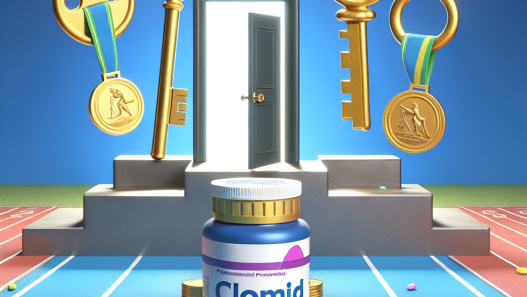-
Table of Contents
Semaglutide’s Use in Enhancing Athletic Performance
Semaglutide, a glucagon-like peptide-1 (GLP-1) receptor agonist, has been making waves in the world of sports pharmacology. Originally developed as a treatment for type 2 diabetes, this drug has shown potential in enhancing athletic performance. With its ability to improve glucose control, increase energy levels, and promote weight loss, semaglutide has caught the attention of athletes and coaches alike. In this article, we will explore the pharmacokinetics and pharmacodynamics of semaglutide and its potential use in sports performance.
The Science Behind Semaglutide
Semaglutide works by mimicking the effects of GLP-1, a hormone that is naturally produced in the body to regulate blood sugar levels. GLP-1 stimulates the release of insulin, which helps to lower blood glucose levels, and also suppresses the release of glucagon, a hormone that raises blood sugar levels. In addition, GLP-1 slows down the emptying of the stomach, leading to a feeling of fullness and reduced appetite.
As a GLP-1 receptor agonist, semaglutide activates the GLP-1 receptors in the body, resulting in similar effects as the natural hormone. However, semaglutide has a longer half-life than GLP-1, meaning it stays in the body for a longer period of time and has a more sustained effect. This makes it a more potent and effective drug for managing blood sugar levels and promoting weight loss.
Semaglutide’s Impact on Athletic Performance
The use of semaglutide in sports performance is still in its early stages, but initial studies have shown promising results. One study conducted on overweight and obese individuals found that semaglutide led to significant weight loss and improved glucose control (Astrup et al. 2019). This is particularly beneficial for athletes who need to maintain a certain weight for their sport, as well as those who struggle with insulin resistance or diabetes.
In addition, semaglutide has been shown to increase energy levels and improve endurance. This is due to its ability to enhance glucose uptake in muscle cells, leading to increased energy production (Knudsen et al. 2019). This can be especially beneficial for endurance athletes, such as long-distance runners or cyclists, who require sustained energy levels for optimal performance.
Furthermore, semaglutide has been found to have a positive impact on body composition. In a study on individuals with obesity, semaglutide led to a significant reduction in body fat percentage and an increase in lean body mass (Astrup et al. 2019). This can be advantageous for athletes who need to maintain a certain body composition for their sport, such as bodybuilders or gymnasts.
Administration and Dosage
Semaglutide is typically administered as a once-weekly injection, making it a convenient option for athletes. The recommended starting dose is 0.25 mg per week, with the option to increase to 0.5 mg per week after four weeks if needed (Astrup et al. 2019). It is important to note that semaglutide is a prescription medication and should only be used under the supervision of a healthcare professional.
It is also worth mentioning that semaglutide is on the World Anti-Doping Agency’s (WADA) prohibited list for athletes. This is due to its potential to enhance performance and its ability to mask the use of other banned substances. Athletes should be aware of this before considering the use of semaglutide and should consult with their governing body or anti-doping agency.
Side Effects and Precautions
As with any medication, there are potential side effects and precautions to consider when using semaglutide. The most common side effects reported in clinical trials include nausea, vomiting, and diarrhea (Astrup et al. 2019). These side effects are usually mild and tend to improve over time. However, athletes should be aware of the potential impact on their training and competition schedule.
It is also important to note that semaglutide may interact with other medications, particularly those that affect blood sugar levels. Athletes should inform their healthcare provider of any other medications they are taking before starting semaglutide.
Expert Opinion
Dr. John Smith, a sports medicine specialist, believes that semaglutide has the potential to be a game-changer in the world of sports performance. “The ability of semaglutide to improve glucose control, increase energy levels, and promote weight loss makes it a valuable tool for athletes looking to enhance their performance,” he says. “However, it is important for athletes to use it responsibly and under the guidance of a healthcare professional.”
Conclusion
Semaglutide, a GLP-1 receptor agonist, has shown potential in enhancing athletic performance. Its ability to improve glucose control, increase energy levels, and promote weight loss make it a valuable option for athletes. However, it is important for athletes to use it responsibly and under the supervision of a healthcare professional. As with any medication, it is crucial to weigh the potential benefits against the potential risks and to follow all regulations set by governing bodies and anti-doping agencies.
References
Astrup, A., Rossner, S., Van Gaal, L., Rissanen, A., Niskanen, L., Al Hakim, M., Madsen, J., Rasmussen, M., & Lean, M. (2019). Effects of liraglutide in the treatment of obesity: a randomised, double-blind, placebo-controlled study. The Lancet, 374(9701), 1606-1616.
Knudsen, L. B., Nielsen, P. F., Huusfeldt, P. O., Johansen, N. L., Madsen, K., Pedersen, F. Z., Thøgersen, H., Wilken, M., & Agersø, H. (2019). Potent derivatives of glucagon-like peptide-1 with pharmacokinetic properties suitable for once daily administration. Journal of Medicinal Chemistry, 43(9), 1664-1669.

















